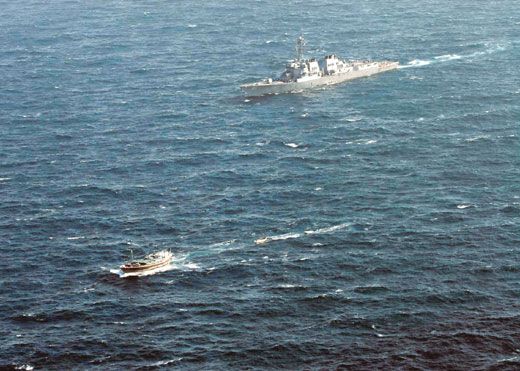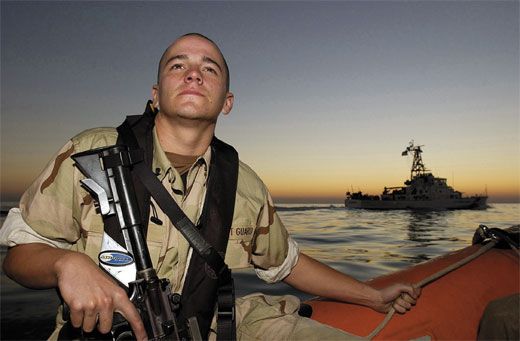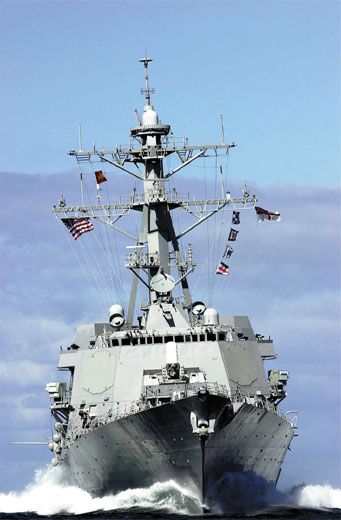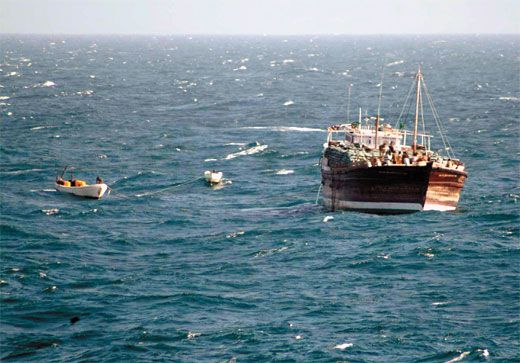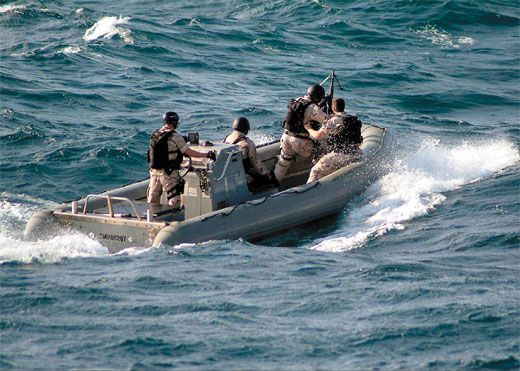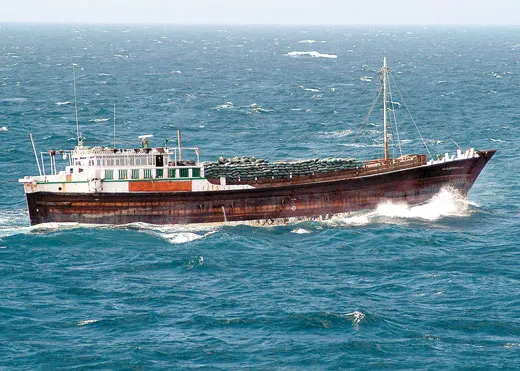The Pirate Hunters
As buccanneering is back with a vengeance, stepped-up law enforcement and high-tech tools work to help protect shipping on the high seas
Editor's Note -- April 9, 2009: In the first capture of an American crew in over 100 years, Somali pirates took hostage the captain of the ship Maersk Alabama after an aborted attempt to seize the cargo on board. Smithsonian revisits its August 2007 article on the challenges facing those who are trying to bring an end to the piracy in the Indian Ocean.
The attack came after daybreak. The Delta Ranger, a cargo ship carrying bauxite, was steaming through the ink-blue Indian Ocean in January 2006, about 200 nautical miles off Somalia's coast. A crewman on the bridge spied two speedboats zooming straight at the port side of his vessel. Moments later, bullets tore into the bridge, and vapor trails from rocket-propelled grenades streaked across the bow: pirates.
A member of the Delta Ranger's crew sounded the ship's whistle, and the cargo ship began maneuvering away as bullets thudded into its hull. The captain radioed a message to distant Kuala Lumpur, Malaysia, where the International Maritime Bureau (IMB) operates the world's only pirate reporting and rescue center. In describing the attack, he added that the pirates seemed to be using a hijacked Indian dhow, a fishing vessel, as their mother ship.
The center's duty officer immediately radioed an alert to all ships in the Delta Ranger's vicinity and found that two other cargo ships had escaped similar attacks in recent days. The duty officer's next message went to the USS Winston S. Churchill, a Navy guided-missile destroyer on patrol about 100 nautical miles from the pirates' last reported position. Soon after, the Churchill headed for the dhow.
Pirates have been causing trouble ever since men first went down to the sea in ships, or at least since the 14th century B.C., when Egyptian records mention Lukkan pirates raiding Cyprus. A millennium later, Alexander the Great tried to sweep the Mediterranean clear of marauding bandits, to no avail. In 75 B.C., ship-based cutthroats took Julius Caesar hostage and ransomed him for 50 talents. The historian Plutarch wrote that Caesar then returned with several ships, captured the pirates and crucified the lot of them.
That hardly spelled the end of pirating. At the beginning of the 13th century A.D., Eustace the Monk terrorized the English Channel, and the European colonization of the Americas, with all its seaborne wealth, led to the so-called golden age of piracy, from 1660 to 1730—the era of Blackbeard, Black Bart, Captain Kidd and other celebrated pirates of the Caribbean. The era ended only after seafaring nations expanded their navies and prosecuted more aggressively to deal with the threat.
Now the seedy romance of the golden-age legends may be supplanted by a new reality: as governments cut their navies after the cold war, as thieves have gotten hold of more powerful weapons and as more and more cargo has moved by sea, piracy has once again become a lucrative form of waterborne mugging. Attacks at sea had become rare enough to be a curiosity in the mid-20th century, but began to reappear in the 1970s. By the 1990s, maritime experts noted a sharp increase in attacks, which led the IMB to establish the Piracy Reporting Centre in 1992—and still the buccaneering continued, with a high of 469 attacks registered in 2000. Since then, improvements in reporting, ship-tracking technology and government reaction have calmed the seas somewhat—the center counted 329 attacks in 2004, down to 276 in 2005 and 239 last year—but pirates remain very much in business, making the waters off Indonesia, Bangladesh, Nigeria and Somalia especially perilous. "We report hundreds of acts of piracy each year, many hundreds more go undetected," says Capt. Noel Choong, head of the Piracy Reporting Centre, in Kuala Lumpur. "Ships and their crews disappear on the high seas and coastal waters every year, never to be seen again." Even stationary targets, such as oil platforms, are at risk.
Global commerce would collapse without oceangoing ships to transfer the world's fuel, minerals and bulk commodities, along with much of its medicines and foodstuffs. According to the U.S. Maritime Administration, about 95 percent of the world's trade travels by water. Boston-based Global Insight, a forecasting company, estimates the value of maritime trade for 2007 to be at least $6 trillion. Estimates of the pirates' annual global plunder range into the billions.
Unlike the galleons of old, which sat low in the water and were easily boarded, the supertankers and bulk carriers of today may rise several stories—and yet they pose no great obstacle to thieves. Bullets and rocket-propelled grenades have persuaded many a captain to stop at sea; at that point, almost any pirate can climb to the deck by tossing grappling hooks over the rail.
Today's pirates range from villainous seaside villagers to members of international crime syndicates. They ply their trade around the globe, from Iraq to Somalia to Nigeria, from the Strait of Malacca to the territorial waters off South America. No vessel seems safe, be it a supertanker or a private yacht. In November 2005, pirates in two speedboats tried to attack the cruise liner Seabourn Spirit off Somalia. The liner's captain, Sven Erik Pedersen, outran them while driving them off with a Long Range Acoustic Device, or LRAD—a sonic weapon the United States military developed after the USS Cole was attacked by Al Qaeda terrorists in Yemen in 2000.
If you enter an anonymous office 35 floors above Kuala Lumpur's lush tropical streets and pass through a secured door, you will come to a small room dominated by maps of the world taped onto two of the walls. This is the IMB's Piracy Reporting Centre, which operates round-the-clock. When pirates attack anywhere in the world, this office almost always receives the first report of it and radios out the first alert. Tens of thousands of vessels depend on the IMB's information.
Red pins mark the latest attacks. On the day I visited, the pins looked like a rash covering much of the world. Another wall was covered with thank-you plaques from the admirals of many nations, including the United States. Noel Choong, who ushered me through this command center, spent more than ten years on oceangoing ships as a mariner. Now, in a dark suit, the soft-spoken Choong looked more like a corporate middle manager than a supersleuth of the seas.
Choong showed me the center's reports on the 239 major pirate attacks it recorded in 2006. One hundred eighty-eight crewmen were taken hostage and 15 were killed—9 in Asia, 4 in Africa and 1 each in the Middle East and South America. "Modern-day pirates can be just as merciless as the Caribbean buccaneers," Choong told me. He recalled the 13 pirates—12 Chinese and 1 Indonesian—who hijacked the Cheung Son, a Hong Kong-registered cargo ship, off China in 1998. "They blindfolded the 23 crewmembers, beat them to death with clubs and threw their bodies overboard," he said. Then they sold the vessel to an unknown party for $300,000. But they were caught, convicted of piracy and murder in a Chinese court, and sentenced to death.
On their way to the firing squad, Choong said, the 13 sang Ricky Martin's bouncy 1998 World Cup soccer theme, "La Copa de la Vida," jumping up and down in their chains as they bellowed the chorus: "Go, go, go, ale, ale, ale." (Afterward, Choong said, "the Chinese charged their families the cost of each bullet" used in the executions.)
Because much of Choong's work is under cover, and because he's been the target of assassination threats, he's careful to protect his anonymity. He has a wide network of informants—usually members of pirate gangs or corrupt government officials looking for a fat payoff—and when a big ship goes missing, he will jet to distant cities at short notice to launch recovery operations. The pirates' going rate for the return of a hijacked ship, he said, is about $800,000. "If I can get it back by paying an informant a fraction of that, then the owners and underwriters are happy."
Recently, an informant called Choong's cellphone to say he knew where pirates were holding a hijacked ship. The next day Choong flew to Bangkok and, in the bar of an airport hotel, listened to the man's offer: the ship's whereabouts in exchange for $50,000.
Choong forwarded the offer to Chinese authorities, who found the ship at anchor in the South China Sea, sporting fresh paint, a new name and a fake registration. After the ship was in hand—Choong said he never pays without results—he arranged a $50,000 deposit to an account the informant kept under a false name. The entire transaction—from phone call to payoff—took no more than a week.
But Choong doubted that the man got to enjoy his loot. "I heard he was murdered by the gang not long after," he said.
Between rounds of whiskey in a plush Kuala Lumpur bar, a ship broker who asked not to be named because of security concerns told me that besides buying and selling ships for his clients, he sometimes arranges ransoms to get their vessels back from hijackers, for about the same sum that Choong had mentioned. "The owners usually pay up without question," he said. Bringing in the authorities "might tie up the ship for weeks, even months, at a port while they investigate the crime. That could lose them millions of dollars."
Of course, not all negotiations go smoothly. Along the coast of Somalia—which Choong pinpointed as one of the world's likeliest areas for pirate attacks—brigands can, and often do, drag out negotiations for months.
"Somalia is chaotic, with gangs of heavily armed men roaming around the land and its seas," James Mriria, a strapping sailor, told me in the Kenyan port of Mombasa. He said he had spent four months in 2001 as a hostage of Somali pirates as they haggled with the Italian owner of a fishing trawler they had hijacked. The bandits, he said, fed their guests just enough food to keep them alive, and often beat them with rifle butts. "It was hell," Mriria said.
The pirates who tried to take the Delta Ranger would head for Somalia too.
In pursuit of the hijacked dhow, the Churchill had the advantage of surprise. The pirates "couldn't see us over the horizon" during the night, the ship's executive officer, Lt. Cmdr. Erik Nilsson, told me in a telephone interview. But at first light the destroyer deliberately showed itself to the crew of the dhow, and the pirates took off to the west. Somalia's territorial waters—from which the Churchill was barred by international law—were 80 nautical miles away.
Nilsson had no doubt this was the right ship. He had gotten a description of it from the captain of the Delta Ranger. In time he would see through his binoculars the 16 Indian crewmembers, on the fo'c'sle, holding up a piece of plywood on which they had spray-painted: SIR PLEASE HELP US.
"We repeatedly radioed and asked [the dhow] to halt," Nilsson said. When the pirates refused, the U.S. sailors called to them over an amplified megaphone, without effect. The chase went on all morning and into the afternoon. With Somali waters only four hours away, the Churchill closed to within 500 yards of the dhow and fired across its bow with its 25-millimeter chain guns. "That got the pirates' attention, and they stopped," Nilsson said.
Some of the Churchill's crew boarded the dhow and took everyone on it into custody. Aboard the destroyer, a Hindi-speaking member of the Churchill crew questioned the dhow's captain. "She found that the pirates had captured the dhow six days earlier and had beaten and imprisoned the crew," Nilsson said. "They'd given the Indians no food during that time and had threatened to kill them if they resisted."
Nilsson said that he had seen the Somalis throw unidentified "objects" over the side during the night. Many pirates try to ditch their weapons in the belief that it would provide less evidence for prosecution, but if that were the case aboard the dhow, it didn't work: the boarding party found an AK-47 stashed in the wheelhouse.
Later that afternoon, the USS Nassau, a 40,000-ton amphibious assault ship and the flagship of the expeditionary strike group to which the Churchill was attached, caught up with the destroyer. Ten Somali pirates were taken to the brig of the larger ship. After consulting with the U.S. Central Command, the Nassau took the Somalis to Mombasa, where Kenyan authorities arrested them and charged them with piracy.
Keeping the world's sea lanes safe for commerce is one goal of what the Navy calls Maritime Security Operations, or MSO. Another is to prevent sea-based terrorism. Choong had told me that piracy was prevalent even in the hazardous waters off Iraq in the northern Persian Gulf.
To get there, I flew to the desert kingdom of Bahrain, headquarters of the U.S. Fifth Fleet, which operates in the Arabian Sea, Red Sea, Gulf of Oman and parts of the Indian Ocean. From there I caught a Navy Desert Hawk helicopter for a two-hour flight to the guided-missile cruiser USS Philippine Sea, my base for a three-day visit. Along the way, the chopper flew fast and low over a sparkling green sea dotted with coral islands, fishing dhows and oil rigs. With the cruiser steaming along, the pilot put us smoothly down on the aft deck.
On board, Australian Navy lieutenant commander Tish Van Stralen, a maritime lawyer, said that the cruiser was the flagship of an eight-ship coalition task force guarding Iraq's nearby Al Basrah and Khawr Al Amaya oil terminals, which were pumping up to 1.6 million barrels a day into the holds of supertankers. "They provide up to 90 percent of Iraq's GDP, and so the coalition forces have set up a pair of adjacent two-mile-wide exclusion zones around the oil terminals," Van Stralen said. "We challenge and check every vessel wanting to enter them, primarily on the watch for terrorists intent on blowing up the oil terminals, but also for pirates and smugglers."
The pirate hunters patrolling the zones were a Coast Guard crew aboard the cutter Aquidneck. The next morning I rode a half hour across a flat sea in a rigid inflatable speedboat to meet them.
Lt. Jonathan Carter and his 22-man crew had spent six months on these volatile waters. Assault rifles were nestled in a rack, and on the small bridge, four sailors hunched over radar and sonar equipment, looking for any vessel trying to enter the exclusion zones.
As the Aquidneck edged up the Shatt Al Arab waterway toward Basra, Carter pointed to an empty stretch of desert about 200 yards on our left. "That's Kuwait," he said. About 200 yards to the right was Iraq—more desert with no sign of life. The cutter passed several rusting hulks resting half out of the water, casualties of Gulf warfare.
"Pirates have been active in these waterways for centuries. There're still plenty of them here, and we call them Ali Baba," Carter went on. "They mostly prey on the fishing dhows, especially during the prawning season when the dhow captains carry plenty of money on board after selling their catch to traders....We'll hear a plea over the radio, 'Ali Baba! Ali Baba!' But by the time we reach the dhow, the pirates have usually escaped. If we surprise them, they throw their weapons overboard."
Coalition naval forces are trying to train Iraqi marines to board, search and, if necessary, seize suspicious vessels. From the north, I saw two patrol boats roaring along the waterway toward us. On board were Iraqi marines under the guidance of a pair of Royal Australian Navy officers. The marines were taking part in a training exercise, and five Coast Guardsmen and I volunteered to play potential terrorists or pirates.
Several grim-faced Iraqi marines clad in camouflage fatigues climbed aboard and forced us up to the front of the Aquidneck. Some pointed their guns at us even though their trainers had ordered them not to, and others searched us and checked our ID. I grimaced when a marine yanked my arms above my head and I tensed as he roughly searched my body for hidden weapons.
They made us sit on the uncovered deck in brutal heat for more than an hour, refusing our requests for water and keeping their guns trained on us. But for all that, our captors failed to detect a knife one of the Aquidneck crew had secreted, and they never searched my camera bag. Had we been actual bad guys, who knows what might have happened.
Last October I drove an hour north of Mombasa, past a string of Kenyan luxury seaside resorts, to talk to any of the ten accused Somali pirates who would speak with me in the maximum-security jail where they were being held. As I waited outside the stone walls, grim-faced prisoners in striped pajamas with short pants came and went, under guard.
By then, the Somalis' trial was under way; the defendants were due in court the following day. Inside the jail, armed guards escorted two of them as they shuffled toward me, handcuffed to each other.
We moved to a bare room with a barred window. The guards followed us, while others crowded the window outside to stare and listen.
Moktar Mohammed Hussein and Abdi Fadar, clad in sarongs and T-shirts, squatted in front of me but did not make eye contact. They were 17 and 18, respectively. "We're fishermen, and our boats broke down on the ocean," Hussein said. "We sought help from the Indian dhow."
Then why were they carrying assault rifles and rocket-propelled grenades, I asked them. "Every man in Somalia carries such weapons for protection," Hussein said, turning his dark eyes on me. That much was corroborated later by the BBC's Mombasa-based correspondent, Peter Greste, who often visits Somalia.
But why did they try to escape when they spotted the American warship? "We thought they suspected us of being Al Qaeda. We were frightened, and so we tried to get away," Fadar said.
"We just want to go home," Hussein added softly.
I reminded them that Indian crewmembers had testified that the Somalis had hijacked their ship and beaten them? Hussein shook his head. "They're lying," he said.
Did they even know any Somali pirates? Both shook their heads no, but stared silently at the floor.
At 3 o'clock the next afternoon, all ten defendants crowded into the dock in a small courtroom to face a senior magistrate, Beatrice Jaden, seated high above us on a pedestal in the British manner. The prosecutor, Margaret Mwangi, read out the charge, accusing them of committing "acts of piracy on the high seas," and ran through the evidence, based on statements from the Indian crew aboard the dhow and the U.S. sailors who had rescued them.
The Somalis' lawyer, Hassan Abdi, argued that because no one involved—neither the victims, the accused nor the alleged perpetrators' captors—was Kenyan, Kenya had no right to try this case in its courts.
Mwangi countered that the U.N.'s Convention on the Law of the Sea allows Kenya to prosecute pirates of any nationality under the corresponding section of the Kenyan penal code. Should the Somalis be found guilty, Mwangi went on, they should be sentenced to death to deter piracy.
Ten days later, Jaden handed down her verdict and the sentence. Guilty. Seven years in prison for each man.
By then, the pirates might have considered themselves lucky. At the time, Somalia was ruled by a fundamentalist Muslim movement called the Islamic Courts Union (ICU), which sought to impose sharia, or Islamic law, when it took over the capital of Mogadishu from its notorious warlords in June 2006. Piracy was one of several crimes punishable by death.
Noel Choong told me that after the ICU takeover the IMB noted a lull in piracy in the waters off Somalia. But the ICU was overthrown and replaced by a transitional government at year's end. Since then, pirate attacks have surged off the Somali coast, from 10 reported to the IMB in all of 2006 to 14 in the first six months of 2007.
In February, pirates off the coast boarded and hijacked the merchant vessel Rozen, which had just delivered food for the U.N. World Food Programme. They held its 12 crewmembers for 40 days until an undisclosed ransom secured their release. Another merchant vessel, the Mariam Queen, was hijacked and held for 24 days before it was freed May 27 after the ship's owner reportedly paid a $100,000 ransom. At the end of that month, the IMB recommended that vessels keep 200 miles offshore unless they were calling into Somali ports.
"We'll never see the end of piracy, just as we'll never see the end of robbery on land," Choong said. "But we're doing everything we can."
Paul Raffaele, a frequent contributor to Smithsonian, wrote about wild dogs in the April issue.
